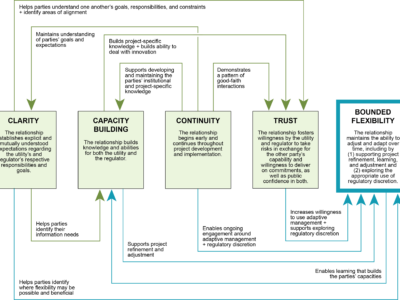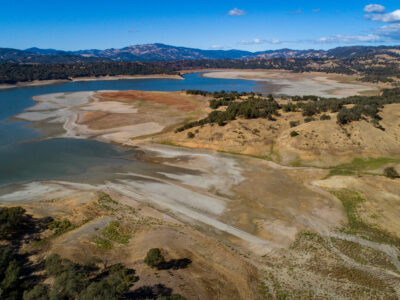Water
UCLA Clinic Submits Amicus Brief in Water Rate Design Case
A trial court decision invalidated the City of San Diego’s tiered water rates. This amicus brief by the Environmental Law Clinic on behalf of California Coastkeeper Alliance and Los Angeles Waterkeeper argues a reversal is needed to pursue conservation and equity.
Court challenges to the use of tiered water rates in California are threatening the state’s own water conservation and affordability goals. That’s what’s at stake in a case called Patz v. City of San Diego. Climate change is intensifying California’s hydrologic variability and exacerbating the state’s water supply challenges. Dwindling water supplies have led …
Continue reading “UCLA Clinic Submits Amicus Brief in Water Rate Design Case”
CONTINUE READINGSackett and the Dangers of a New ‘Clear-Statement Rule’
The Supreme Court decision in Sackett v. EPA will be bad for the nation’s wetlands. It is just as bad for democracy.
The Supreme Court decision in Sackett v. EPA limits the Environmental Protection Agency’s ability to defend a large portion of the nation’s wetlands and waterways from pollution. The decision strips key environmental protections from the Clean Water Act by narrowly defining which bodies of water can be regulated under the Act, making it the most …
Continue reading “Sackett and the Dangers of a New ‘Clear-Statement Rule’”
CONTINUE READINGA decade of unraveling the effects of regulation on water innovation
By Michael Kiparsky, with Dave Smith, Nell Green Nylen, Luke Sherman, Alida Cantor, Anita Milman, Felicia Marcus, David Sedlak, Bernhard Truffer, Christian Binz, Sasha Harris-Lovett, Jeff Lape, Justin Mattingly, Dave Owen, Lars Tummers, Buzz Thompson
In a recent post, my colleagues and I reported on our most recent research output in a long series of projects examining the effect of regulation on water innovation. The post describes a new framework for understanding and, ultimately, improving relationships between regulators and wastewater utility managers who are seeking to implement novel technical solutions, …
Continue reading “A decade of unraveling the effects of regulation on water innovation “
CONTINUE READINGThe role of regulatory relationships in wastewater innovation
by Nell Green Nylen, Michael Kiparsky, and Anita Milman
Public water and wastewater utilities are increasingly struggling to meet society’s expectations. Their basic infrastructure is aging, budgets are tight, and they face a barrage of stressors, from population growth to climate change and shifting regulatory expectations. What’s more, in addition to performing their traditional function of protecting human health and water quality, many wastewater …
Continue reading “The role of regulatory relationships in wastewater innovation”
CONTINUE READINGTo Manage Water Scarcity, California Needs a Framework for Fair and Effective Water Right Curtailment
by Nell Green Nylen, Dave Owen, Jennifer Harder, Michael Kiparsky, and Michael Hanemann
After three years of drought, a parade of storms brought flooding, landslides, and a massive snowpack to California. With water temporarily so abundant, it is tempting to push planning for water scarcity to the back burner. But California does not have this luxury. The state’s water management challenges during wet and dry times interrelate, and …
CONTINUE READING2150 and Beyond
Climate change’s long term effects on the planet will be profound.
Most climate change projections end at the end of this century. When the IPCC issued its first report, however, 2100 was 110 years in the future. Looking that far ahead right now would bring us closer to 2150 than to 2100. We’re only beginning to get a sense of the impacts of climate change that …
Continue reading “2150 and Beyond”
CONTINUE READINGProposed Legislation Would Make Groundwater Adjudications More Fair
Guest Contributors Adrianne Davies, Owen McAleer, and Gabi Rosenfeld explain AB 779, a bill they worked on with State Assemblymember Lori Wilson.
By Adrianne Davies, Owen McAleer, and Gabi Rosenfeld California’s groundwater adjudication process is complex and inaccessible for many water users. As students in UCLA Law’s California Environmental Legislation and Policy Clinic, we partnered with State Assemblymember Lori Wilson’s office to find ways to improve this process. This project resulted in the introduction of AB 779, which will …
Continue reading “Proposed Legislation Would Make Groundwater Adjudications More Fair”
CONTINUE READINGCritical Native American Water Rights Cases Come Before the Supreme Court: Arizona v. Navajo Nation
The Navajo Nation Has the Equities on Its Side, But the U.S. Department of the Interior May Well Have the Law in Its Favor
Today the U.S. Supreme Court hears oral arguments in the last natural resources cases on its docket this Term: Arizona v. Navajo Nation and U.S. Department of the Interior v. Navajo Nation. These consolidated cases are consequential for several reasons: to determine the scope of the federal government’s trust obligations to Native American tribes; to …
CONTINUE READINGCutting 290,000 Tons of Water Pollution a Year, One Coal Plant at a Time
Coal is a dirty fuel. It’s not just air pollution or climate change.
EPA proposed new regulations next week to reduce the water pollution impacts of coal-fired power plants. As EPA regulations go, these count as fairly minor. They got a bit of news coverage in coal country and industry publications. But they will eliminate the discharge of thousands of tons of pollutants, including a lot of metals …
Continue reading “Cutting 290,000 Tons of Water Pollution a Year, One Coal Plant at a Time”
CONTINUE READINGWhy Can’t We All Get Along On The Colorado River?
Maybe It Is Time For the Interior Secretary To Settle The Issue — And For Newspapers To Get Rid Of Op-Eds
Well, this was intriguing. An op-ed from ran with this evocative title: California and its neighbors are at an impasse over the Colorado River. Here’s a way forward. Its author was Eric Kuhn, a former general manager of the Colorado River Water Conservation District and a co-author of “Science Be Dammed: How Ignoring Inconvenient Science …
Continue reading “Why Can’t We All Get Along On The Colorado River?”
CONTINUE READING












